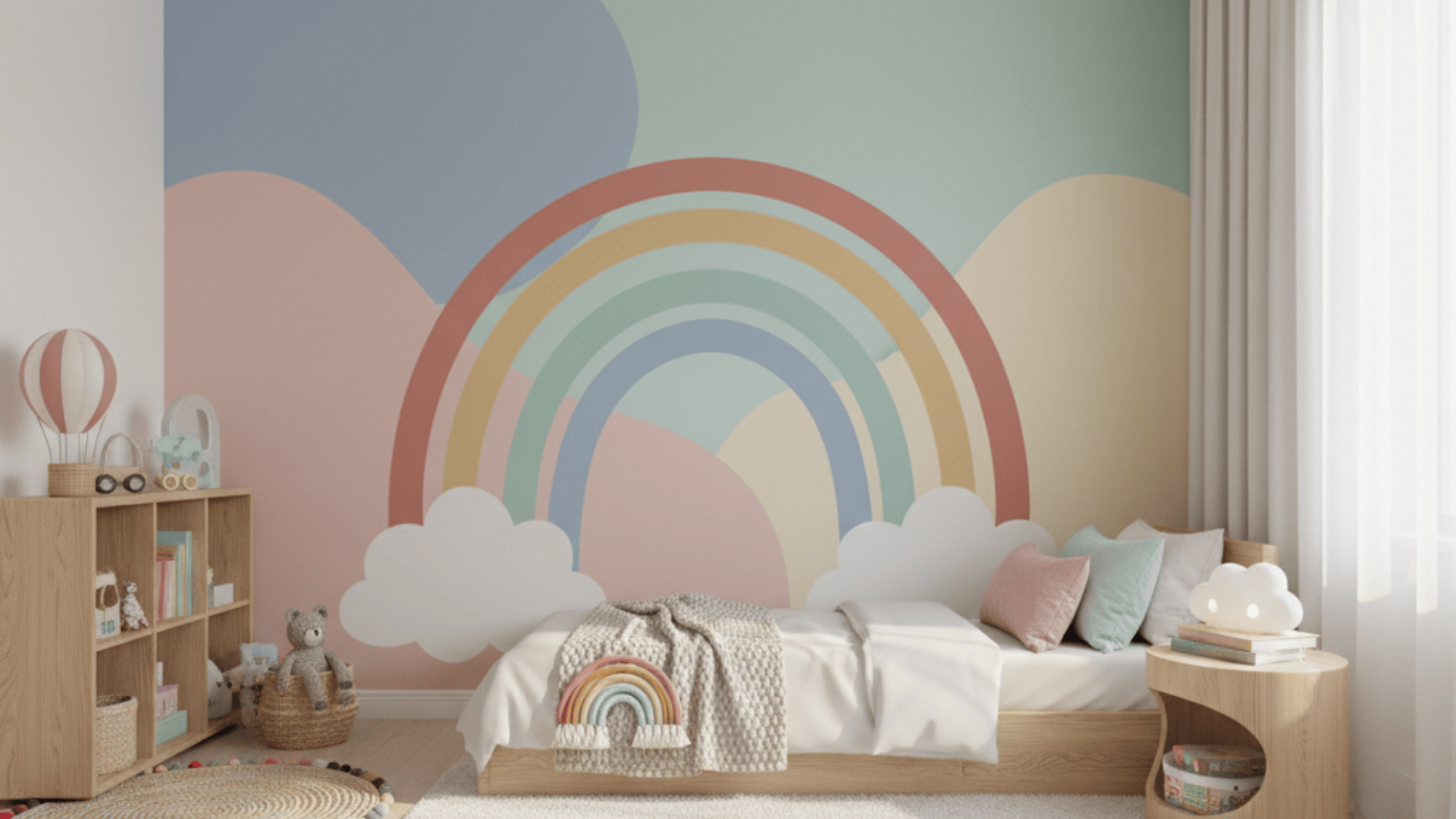Paint has the power to shape how kids feel and interact in their rooms.
The right colors can create a calming space for rest, add brightness for play, or provide a flexible backdrop that grows with them.
This guide includes kids’ room paint ideas suited for every stage, from nurseries to teen bedrooms.
It highlights calming shades, playful designs, and creative paint techniques that make spaces both fun and practical. Tips on safe, durable paints are included along with trending color ideas that are easy to bring into any home.
Color Psychology for Kids’ Bedrooms
The colors you choose can influence how your child feels and behaves in their room. Picking the right shade can support sleep, play, and focus.
Soft blues and greens are calming. They create a peaceful space that helps kids relax and wind down at night.
Yellows and oranges bring energy and warmth. These shades encourage creativity and make the room feel cheerful during the day.
Neutral tones like beige, gray, or soft white are versatile. They work as your child grows and allow you to update the room with new accents over time.
Kids’ Room Paint Ideas
Painting a child’s room sets the tone for how they play, learn, and rest. The right colors can spark creativity, create calm, and even make spaces feel larger or cozier.
1. Gentle Pastels

Soft pastels like mint, peach, and butter yellow create a calming environment for newborns. These shades bring a sense of peace while leaving room for playful accents.
Pastels are easy to pair with furniture and can grow with your child through the toddler years. They also make the nursery feel cheerful without being too bright.
2. Soothing Neutrals
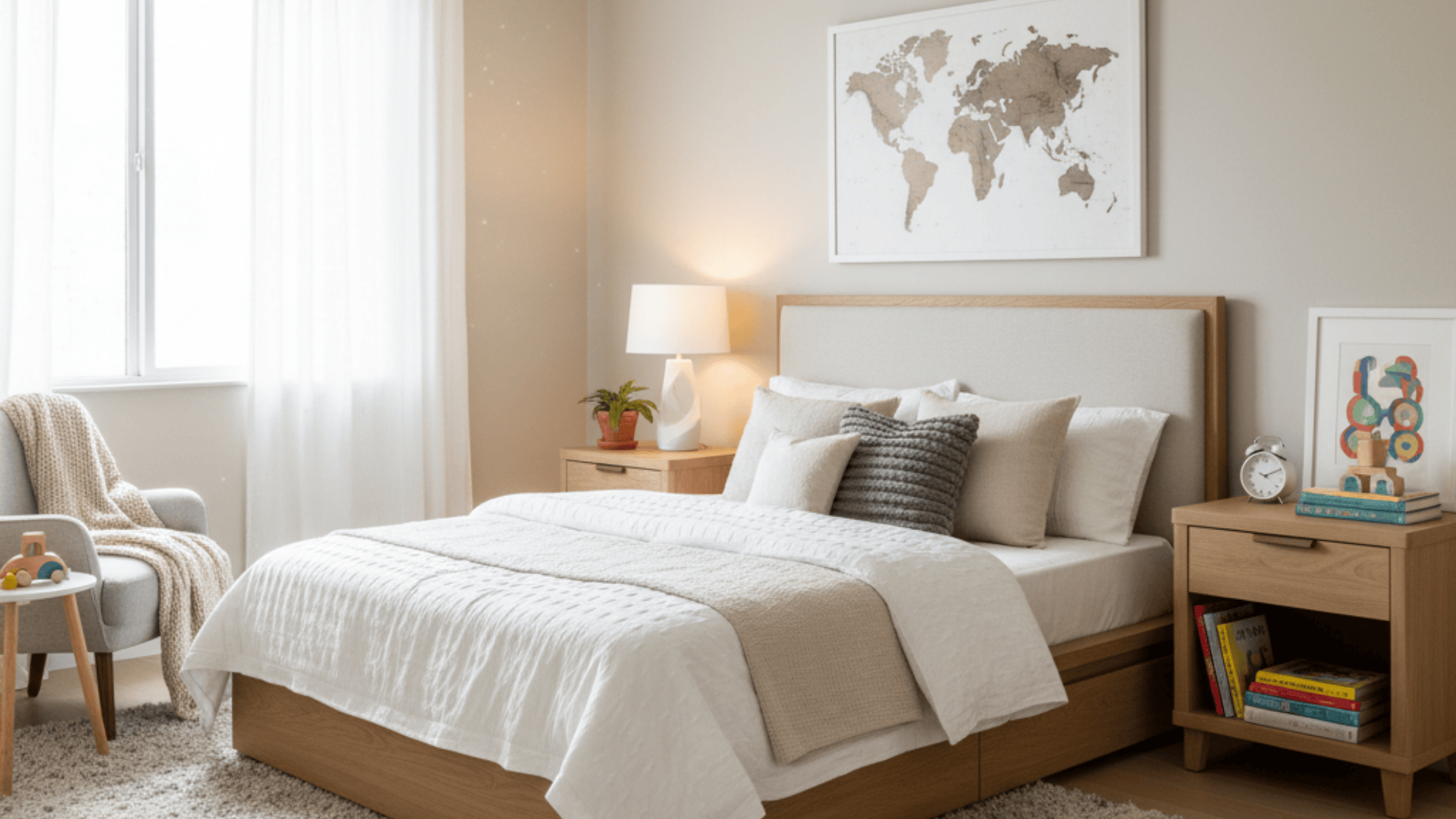
Warm creams, beiges, and light grays provide a timeless backdrop. Neutral walls make it simple to refresh the room with colorful accessories, toys, and art.
They also transition well as your child’s personality begins to show, making them a safe and versatile choice. Neutrals are perfect if you want a soft and balanced atmosphere.
3. Sky-InspiredCeilings
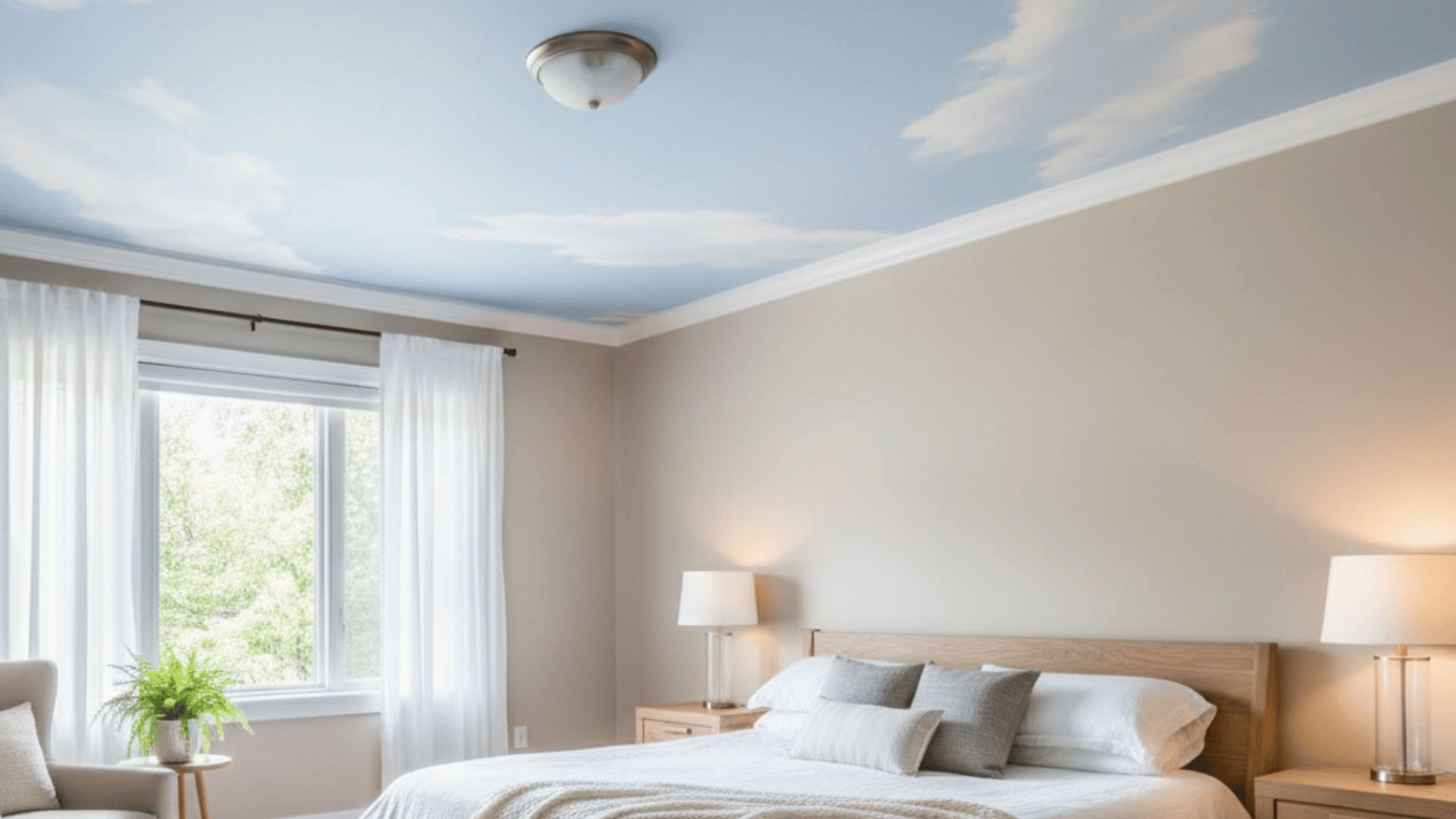
Painting the ceiling in a soft sky blue with white clouds creates a dreamy nursery effect. Babies spend a lot of time looking up, so this calming view adds charm.
It’s subtle but makes the space feel thoughtful and cozy for nap and playtime. A sky ceiling can also help lull little ones to sleep.
4. Two-Tone Calm Walls

Split walls with two soft shades, such as pale green on the bottom and white on top. This adds dimension and protects lower walls from marks and scuffs.
It also creates a more visually interesting space without being overstimulating for infants. The dual look feels stylish while still remaining soothing.
5. Warm Beige with Accents
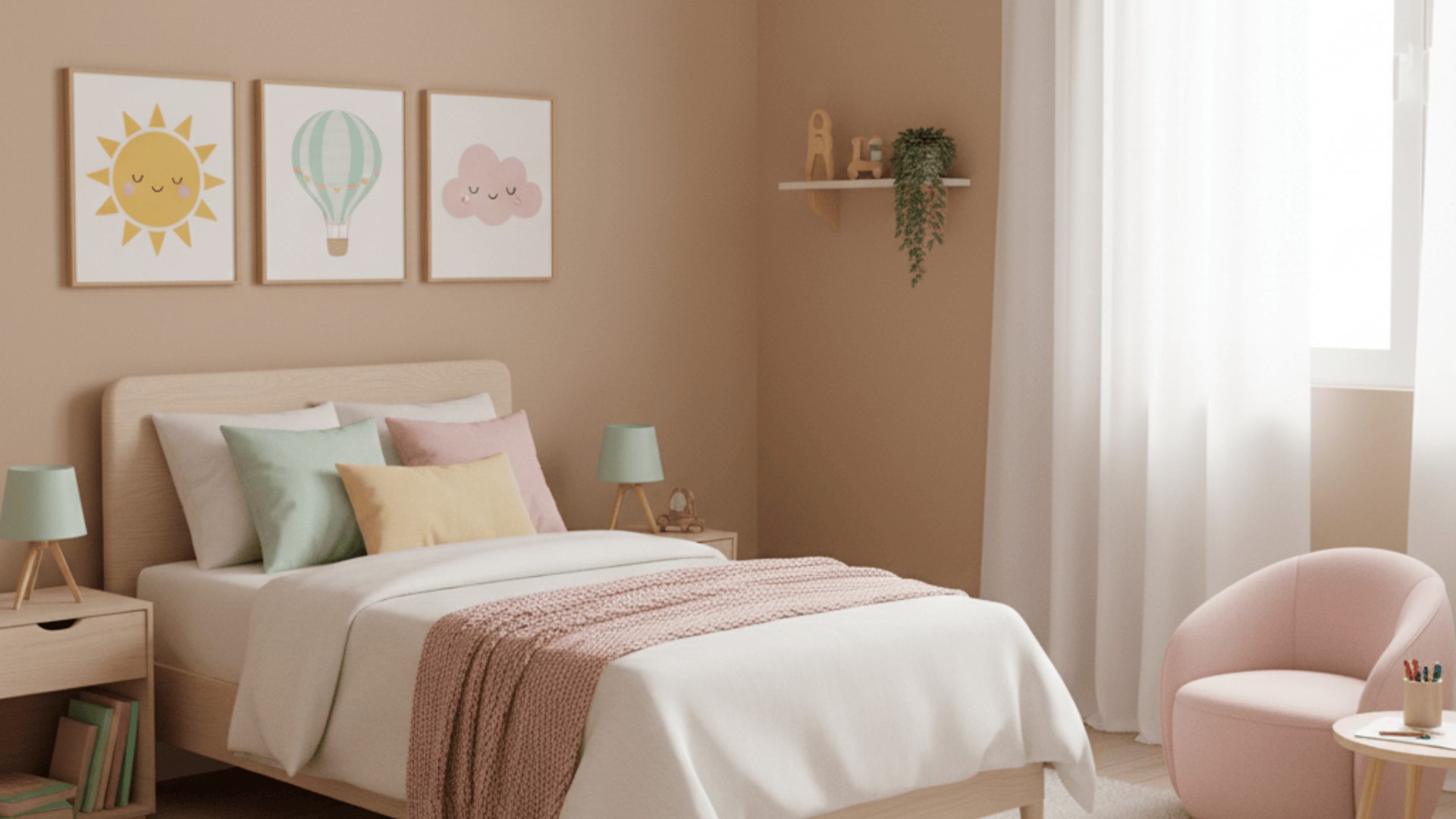
A warm beige base paired with pastel pink, mint, or yellow accents makes the nursery cozy and adaptable. Parents can update textiles and artwork without needing a full repaint.
This approach keeps the room fresh as your baby grows into toddlerhood. It’s a choice that balances warmth with flexibility.
6. Bright Playful Colors
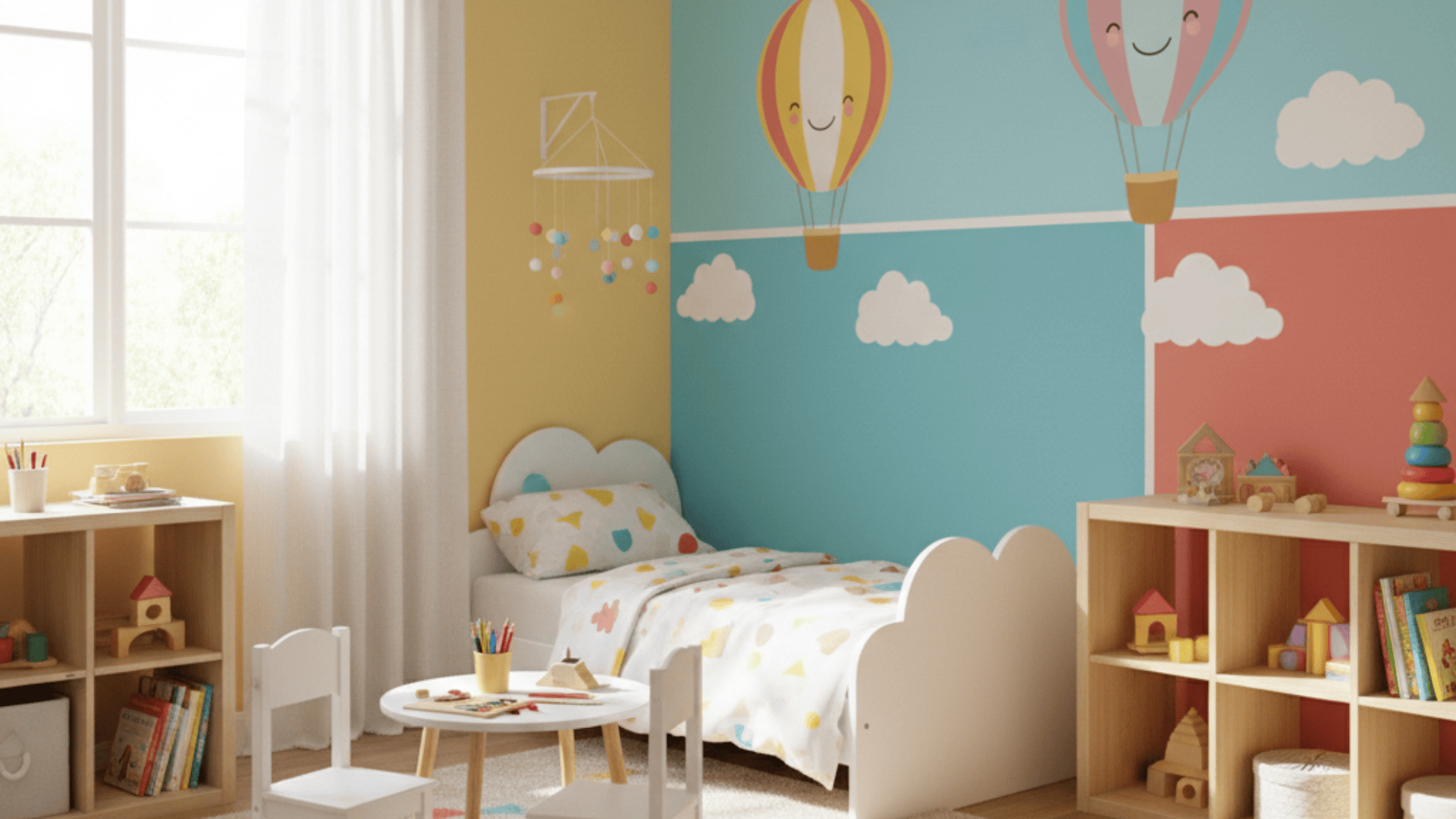
Cheerful yellows, aqua blues, and coral pinks bring energy and excitement to kids’ rooms. These shades inspire creativity and make spaces lively for early childhood.
Pairing bright walls with lighter surroundings keeps the balance, creating a playful environment that encourages daily fun without overwhelming the overall look of the room.
7. Jungle Themed Walls
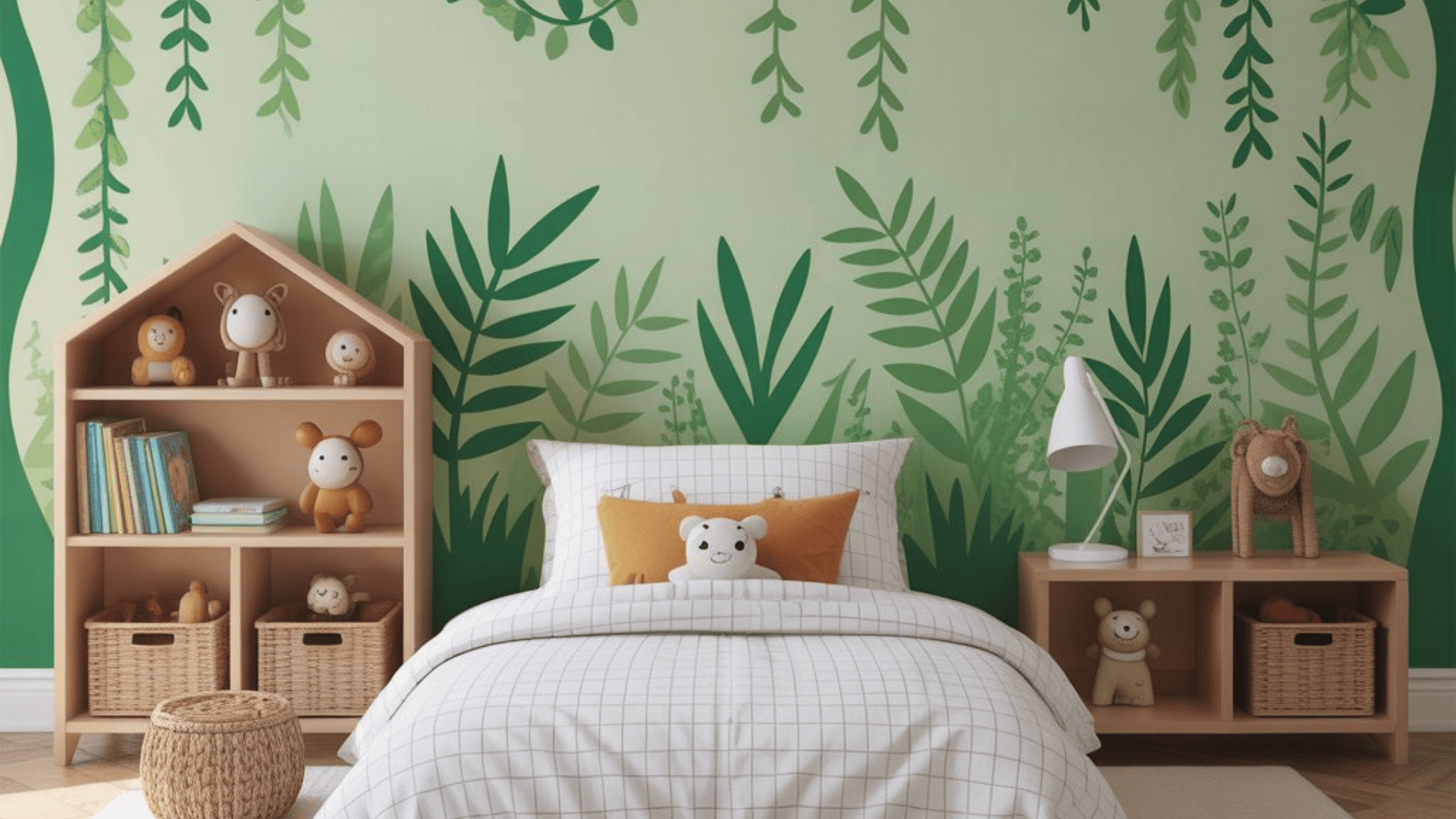
Lush greens with leafy stencils or painted vines create a fun jungle theme. This playful design works well as a backdrop for reading corners or toy storage.
It feels exciting without being overwhelming, while also sparking curiosity about nature and adding a lively touch to a child’s room.
8. Ocean-Inspired Blues
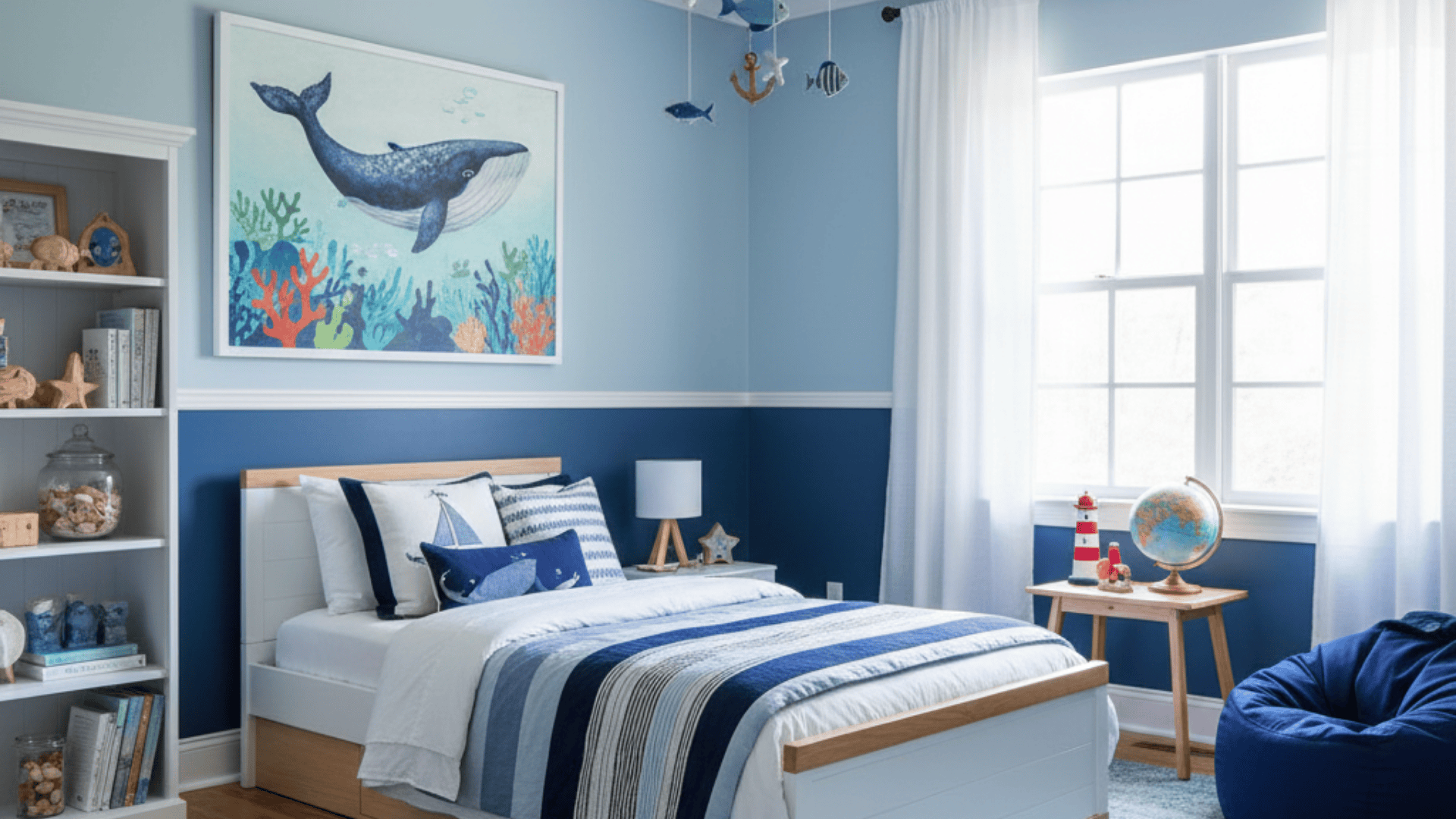
Soft turquoise with waves or sea-life motifs creates a fun underwater escape. This works well for kids who love the beach or sea creatures.
It’s playful, calming, and easy to pair with nautical decor or bedding. The ocean theme gives a refreshing vibe to the whole room.
9. Rainbow Accents

A bold rainbow arc on one wall creates a cheerful focal point in a child’s room. Softer shades on surrounding walls keep the space balanced and not overwhelming.
This design adds joy and positivity, making the room brighter and more uplifting, even on dull or gloomy days.
10. Playful Stripes
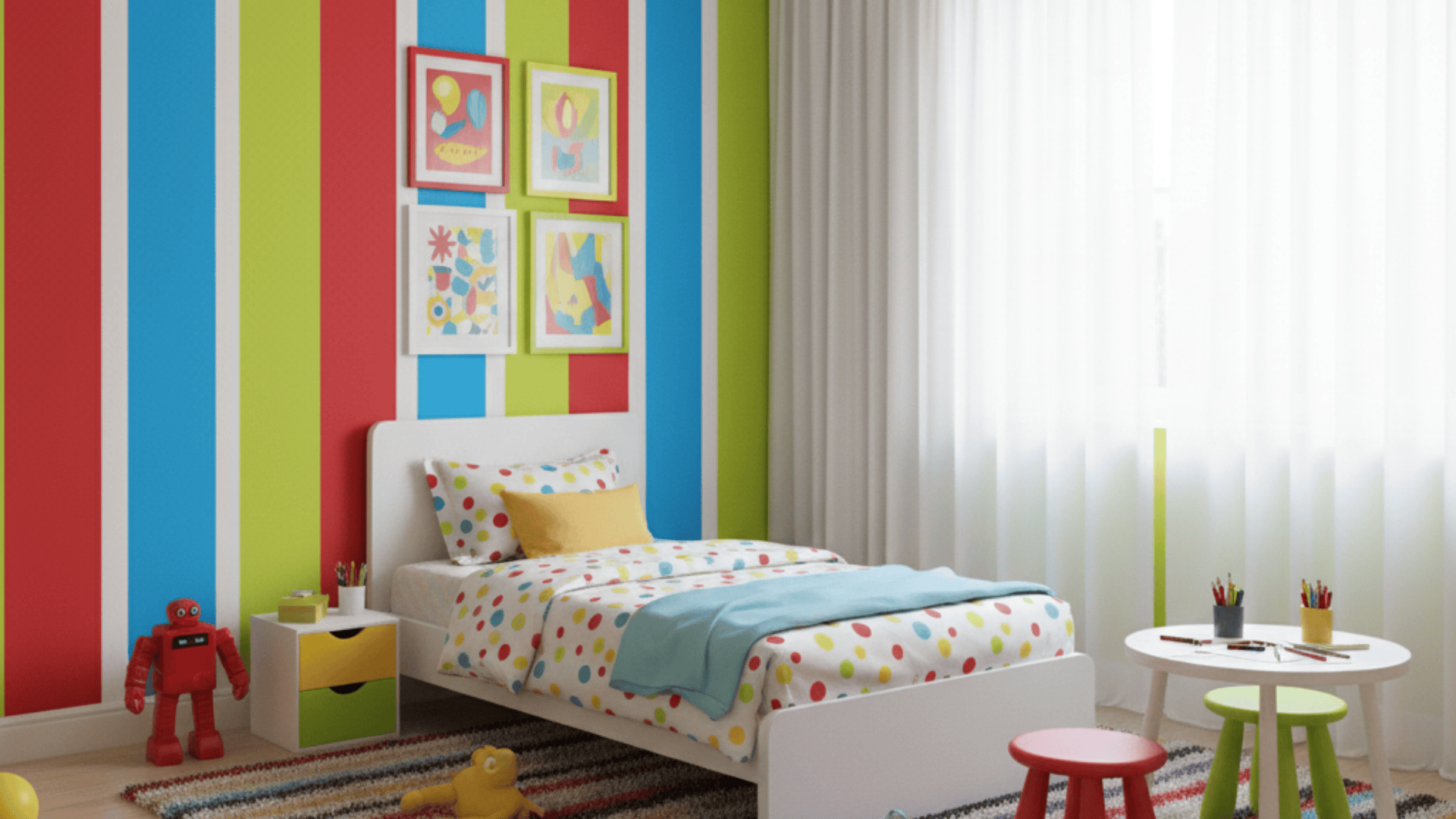
Wide horizontal or vertical stripes in bright contrasting colors add fun and energy. Stripes can make rooms feel taller or wider, depending on orientation.
They’re great for active kids who want a space that reflects their high energy. Stripes also add a modern and stylish touch.
11. Moody Accent Wall

A deep navy, charcoal, or forest green behind the bed instantly creates sophistication. This accent wall adds personality while leaving the rest of the space lighter and more open.
It’s a great choice for teens who want a grown-up vibe. Accent walls also make furniture and decor stand out.
12. Dusty Rose Trend
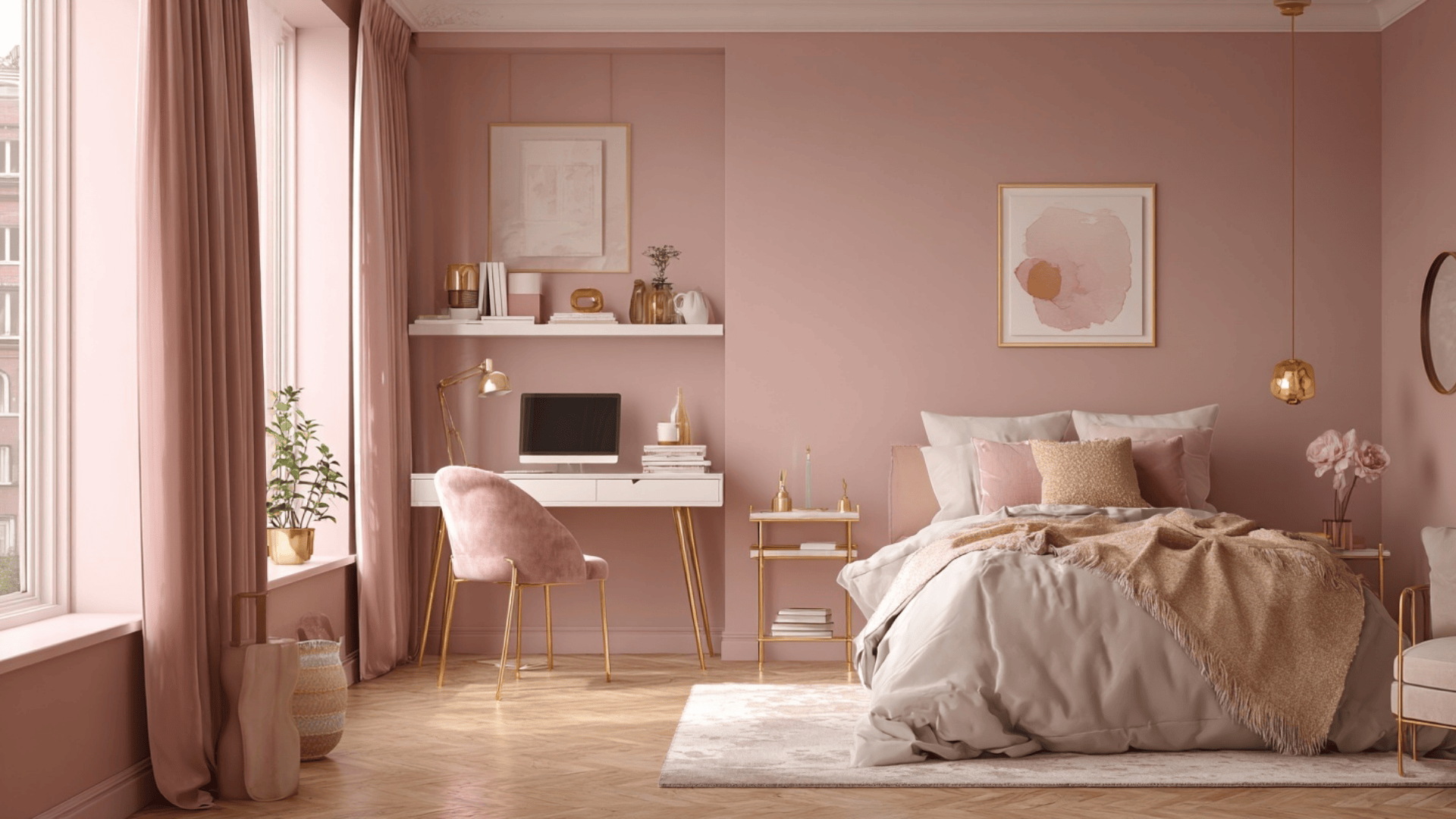
Dusty rose walls create a soft, stylish look that feels mature while keeping a playful touch. This shade pairs well with gold or gray accents for a modern bedroom.
It adds warmth and coziness, making the space inviting and adaptable as teens grow into young adulthood.
13. Muted Sage Green
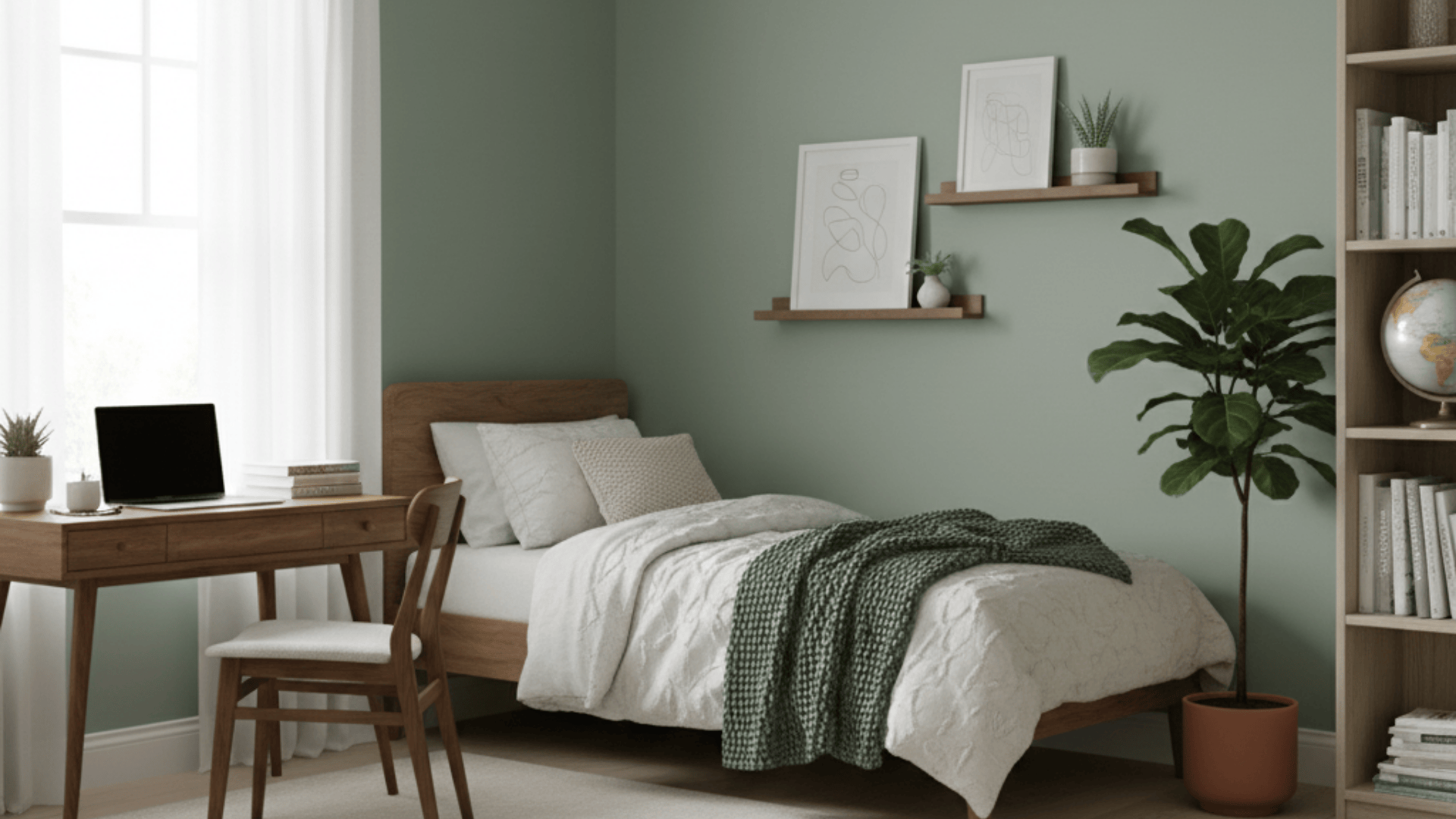
Sage green offers a calm, grounding backdrop that works for studying and relaxing. It’s versatile enough to mix with wood, metal, or colorful decor.
This shade grows beautifully into adulthood without feeling outdated. Sage is also known for creating a peaceful, fresh atmosphere.
14. Two-Tone Statement Walls

Pairing bold navy on the bottom with white on top makes the room stylish and easy to maintain. The darker half hides marks, while the lighter half keeps the room airy.
It strikes a perfect balance between fun and practicality. This design also makes the room look taller.
15. Graphic Geometric Designs

Triangles, hexagons, or chevron patterns in muted colors add a modern, edgy look. This design feels cool without being too childish and can easily be refreshed with new shades later.
Perfect for teens who want something unique. Geometric walls add structure and personality at once.
16. ChalkboardWall
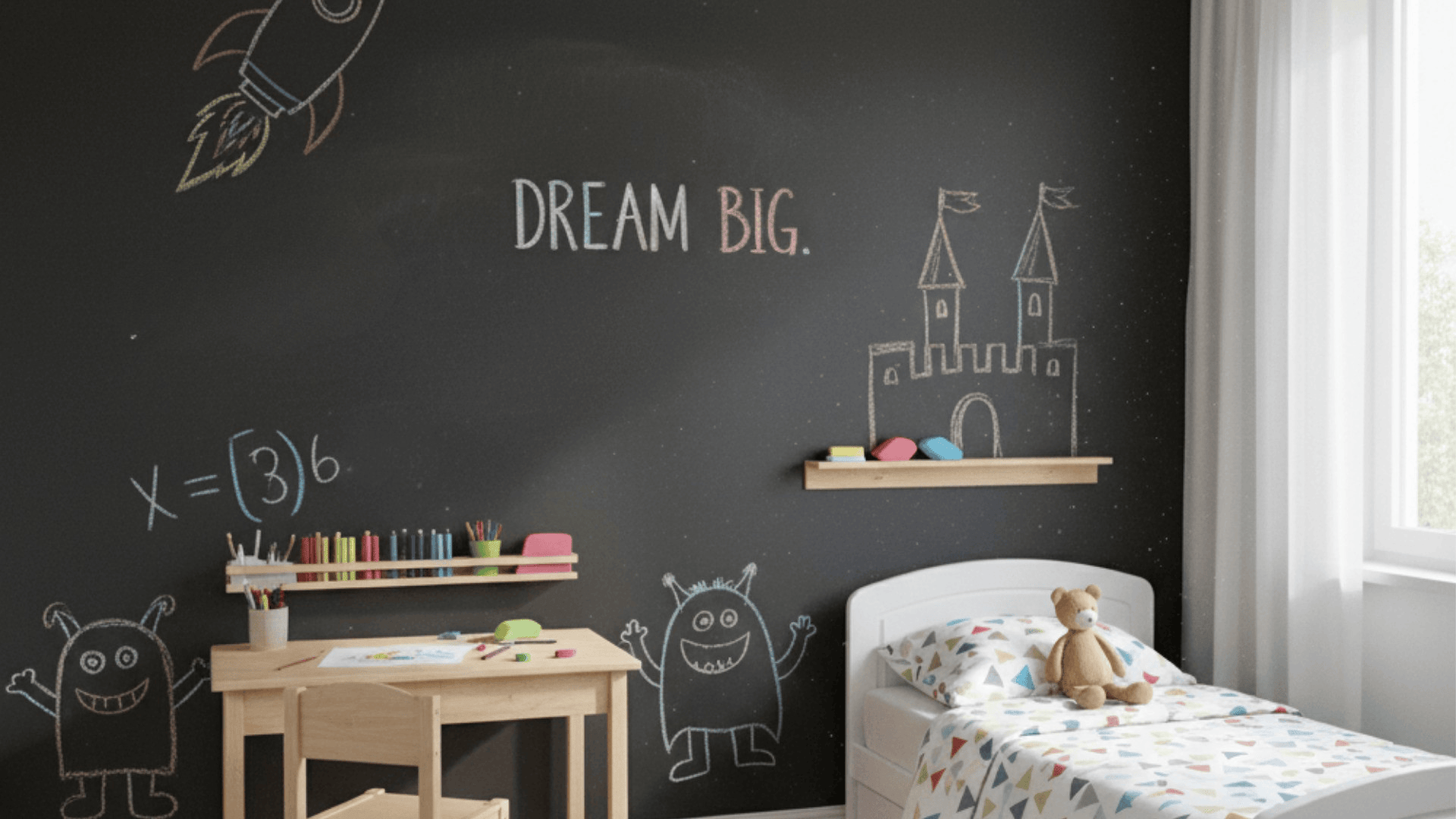
A chalkboard wall turns any room into a canvas for doodling, writing, or math practice. It’s interactive, fun, and easily erasable, giving kids endless creative opportunities while saving paper.
Kids enjoy having a space that’s truly their own to design.
17. MagneticWall
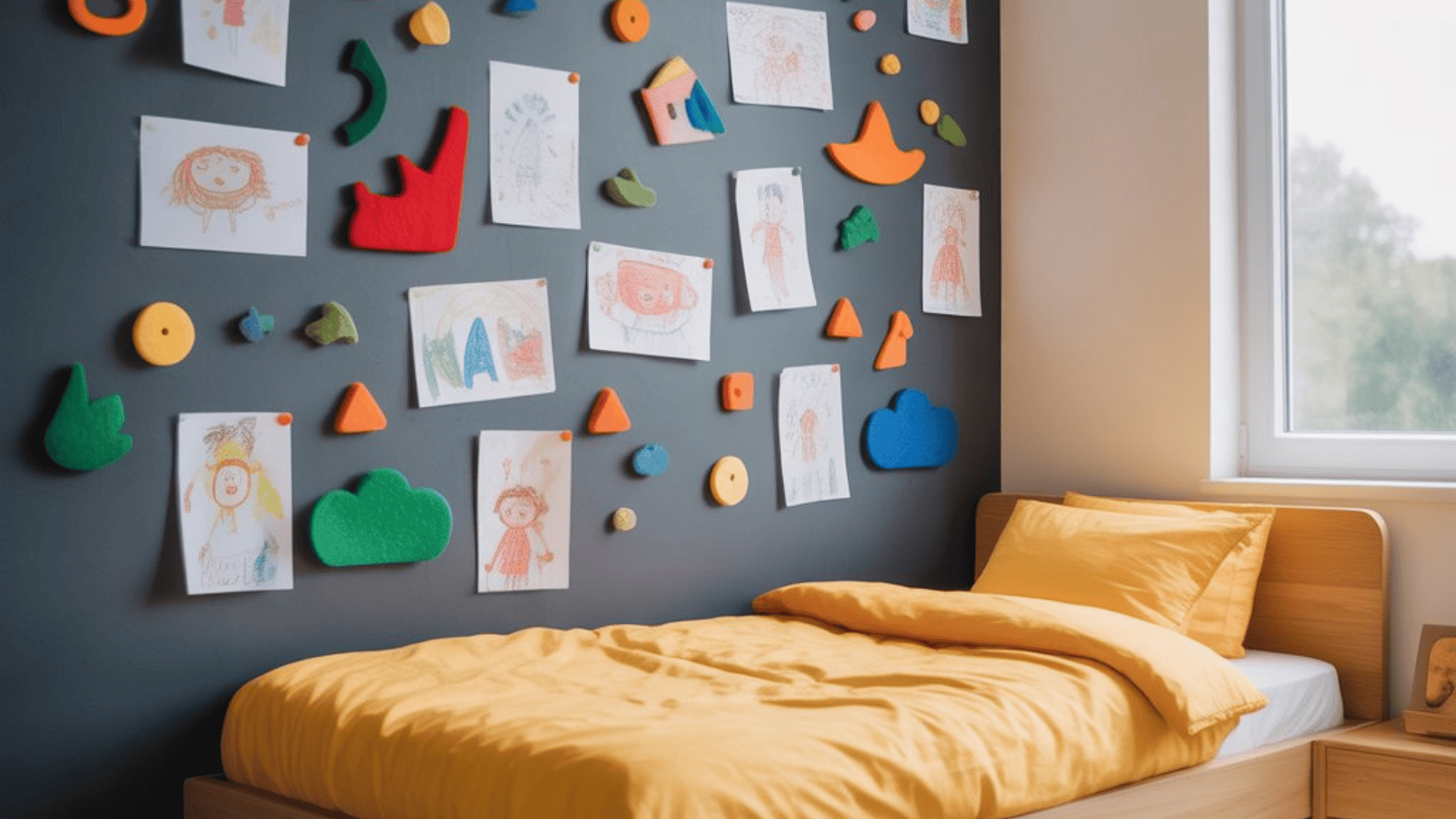
Magnetic paint lets kids display their art, notes, or even learning tools directly on the wall. It keeps things organized while encouraging creativity and independence.
This idea grows well with school-aged children. It’s also easy to combine with bold accent colors. This feature also helps kids feel ownership of their room by designing it themselves.
18. Hand-Made Murals
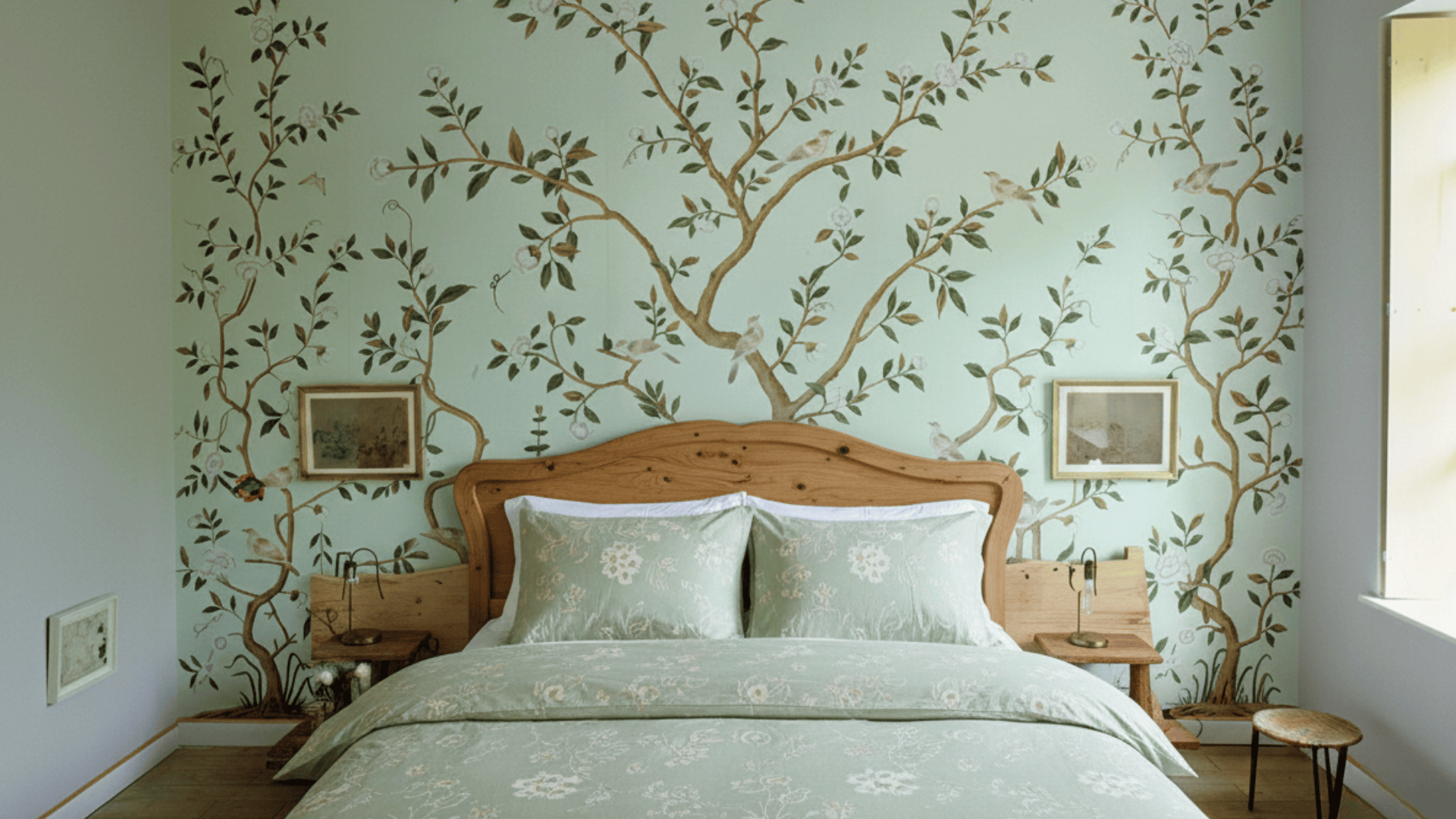
Murals add storytelling to rooms. A forest, galaxy, or cityscape can inspire imagination and serve as a personalized feature wall.
They work across ages and feel like a special custom touch. Murals also make the room feel one-of-a-kind and meaningful.
19. Painted Trims
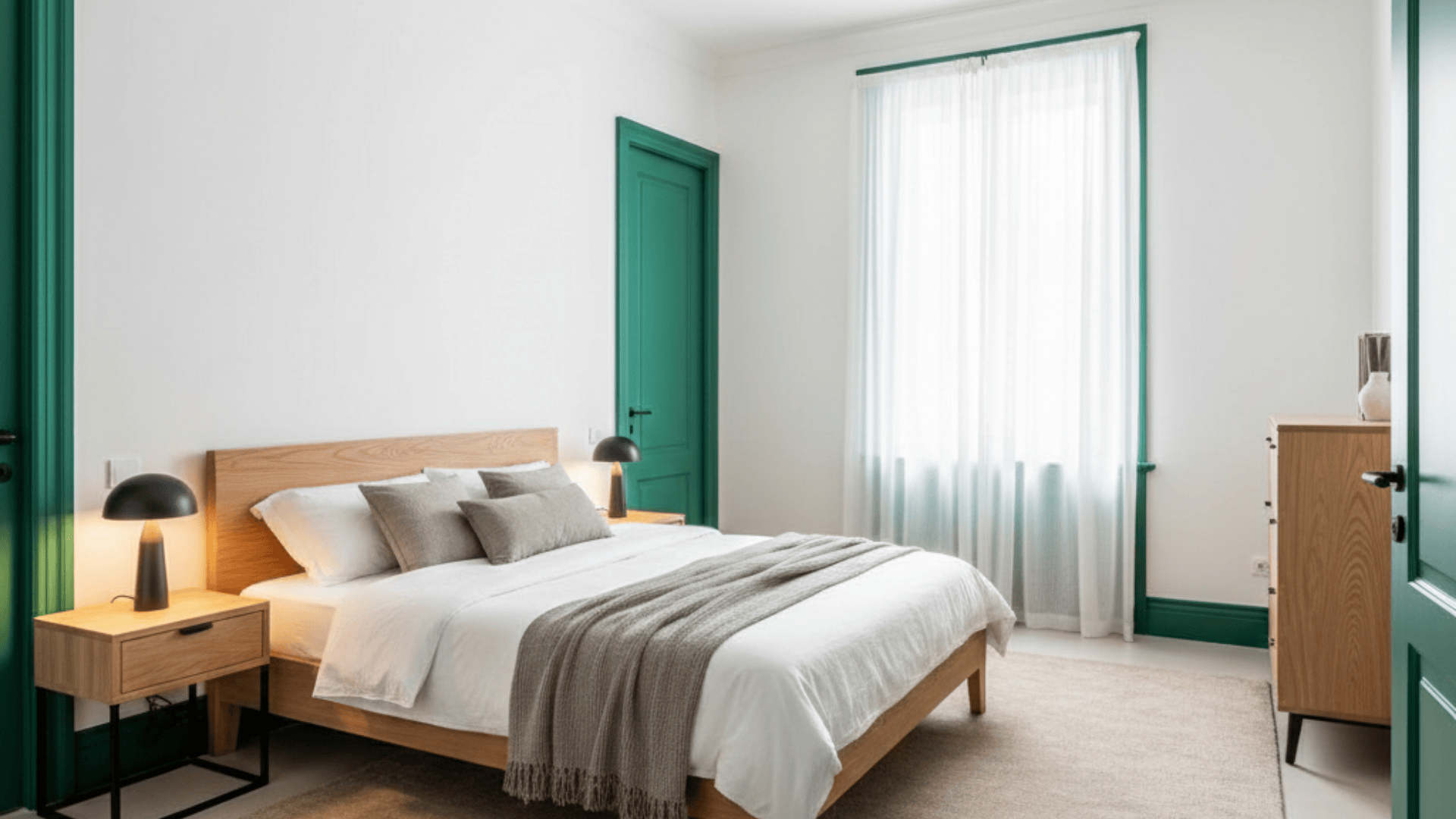
Painting door frames, baseboards, or window sills in a bold color adds subtle charm. For example, white walls with emerald green trims look modern and playful.
It’s easy to update over the years without repainting the entire room. Trims highlight details that are often overlooked.
20. Ceiling Stars and Patterns
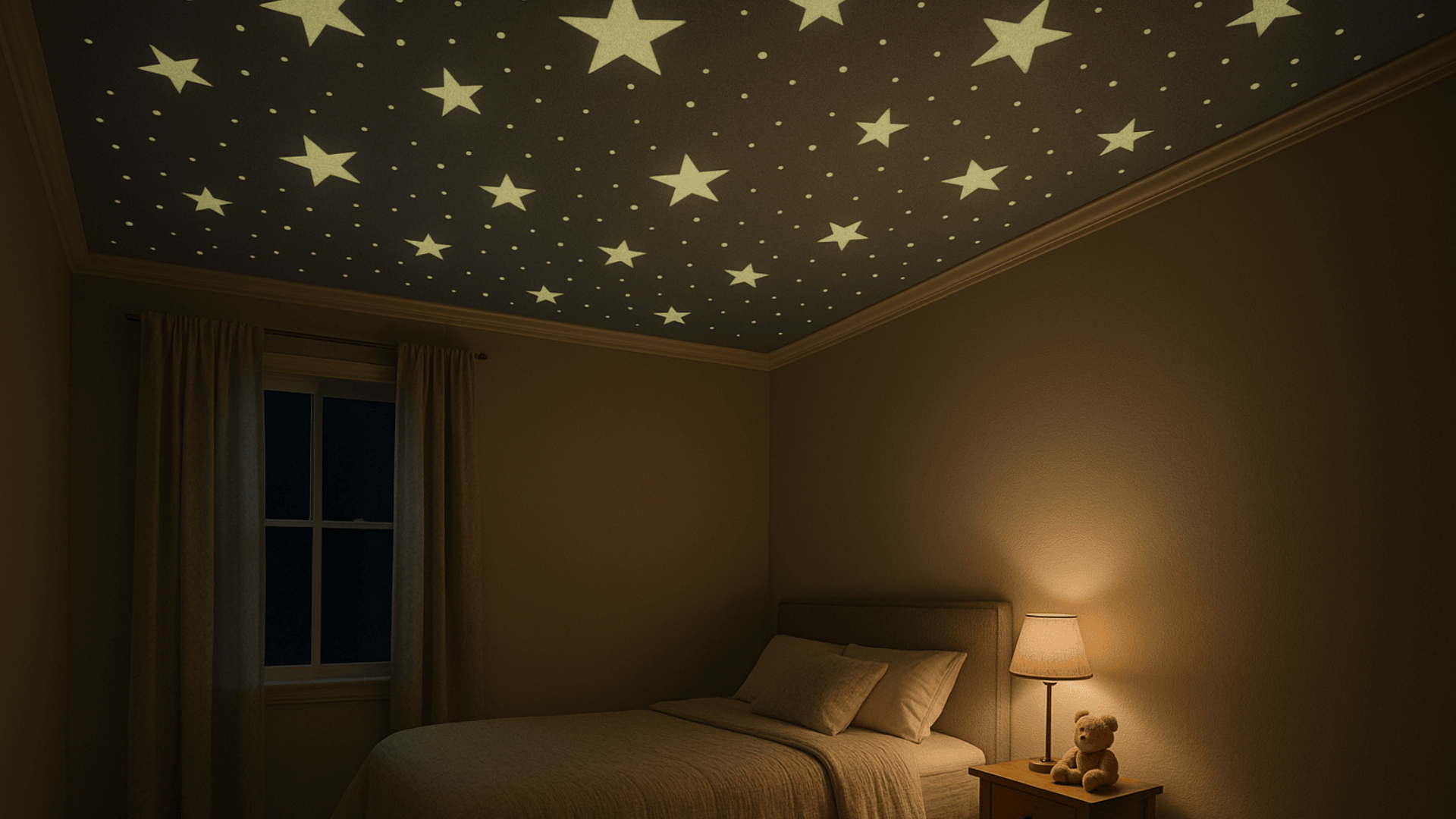
Adding stars, clouds, or geometric shapes on the ceiling makes bedtime more fun. Glow-in-the-dark stars can create nighttime magic while keeping the ceiling playful yet subtle during the day.
This design makes ceilings an engaging part of the room’s style and also makes bedtime enjoyable, and adds personality to an often-overlooked surface.
21. Bold Blues
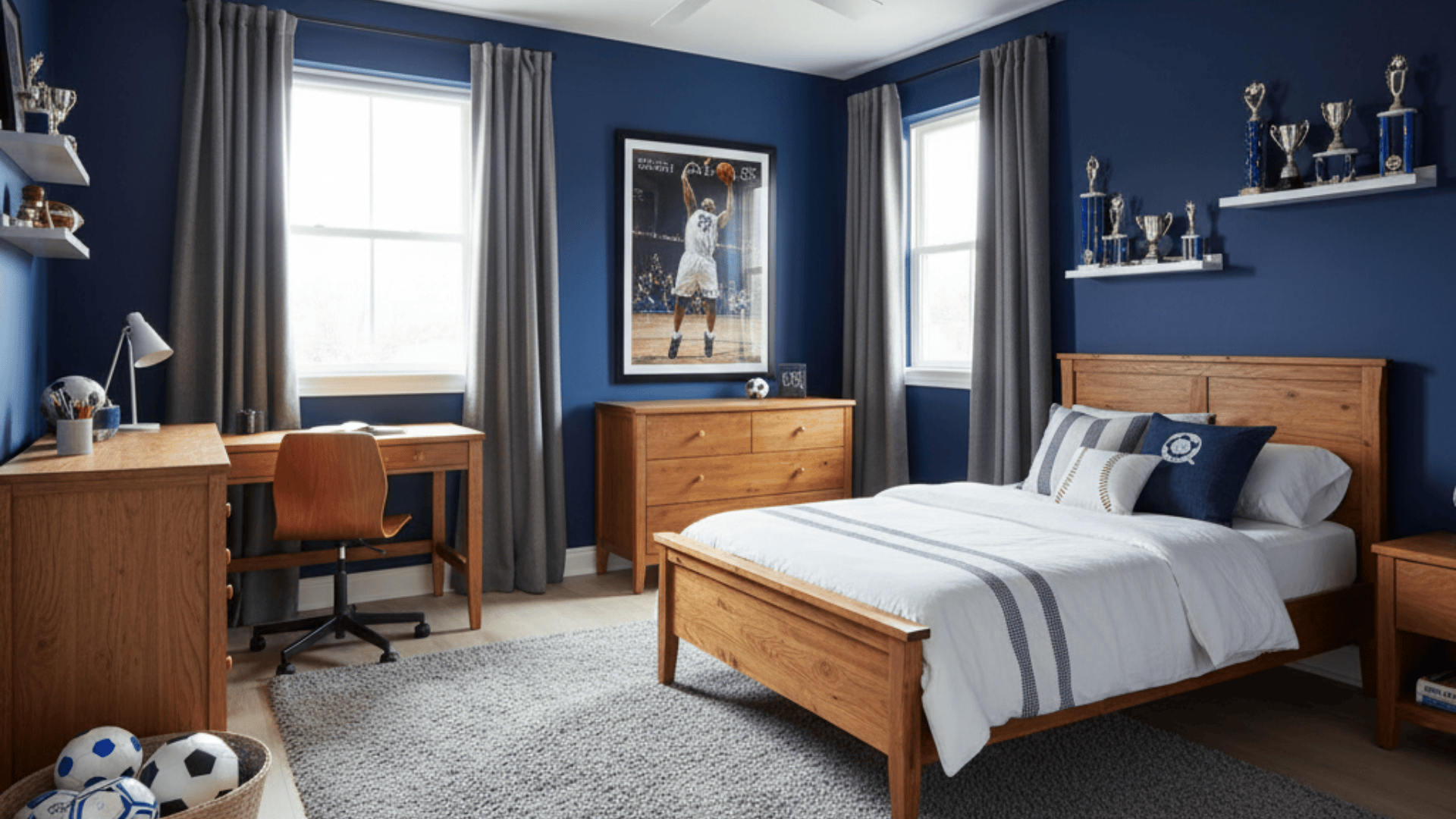
Blue is a classic choice that suits every stage, from toddlers to teens. Shades range from calming sky blue to bold navy, each bringing a different mood.
Blue pairs well with wood or white accents, creating rooms that feel timeless, balanced, and adaptable for growing children.
22. Sporty Greens
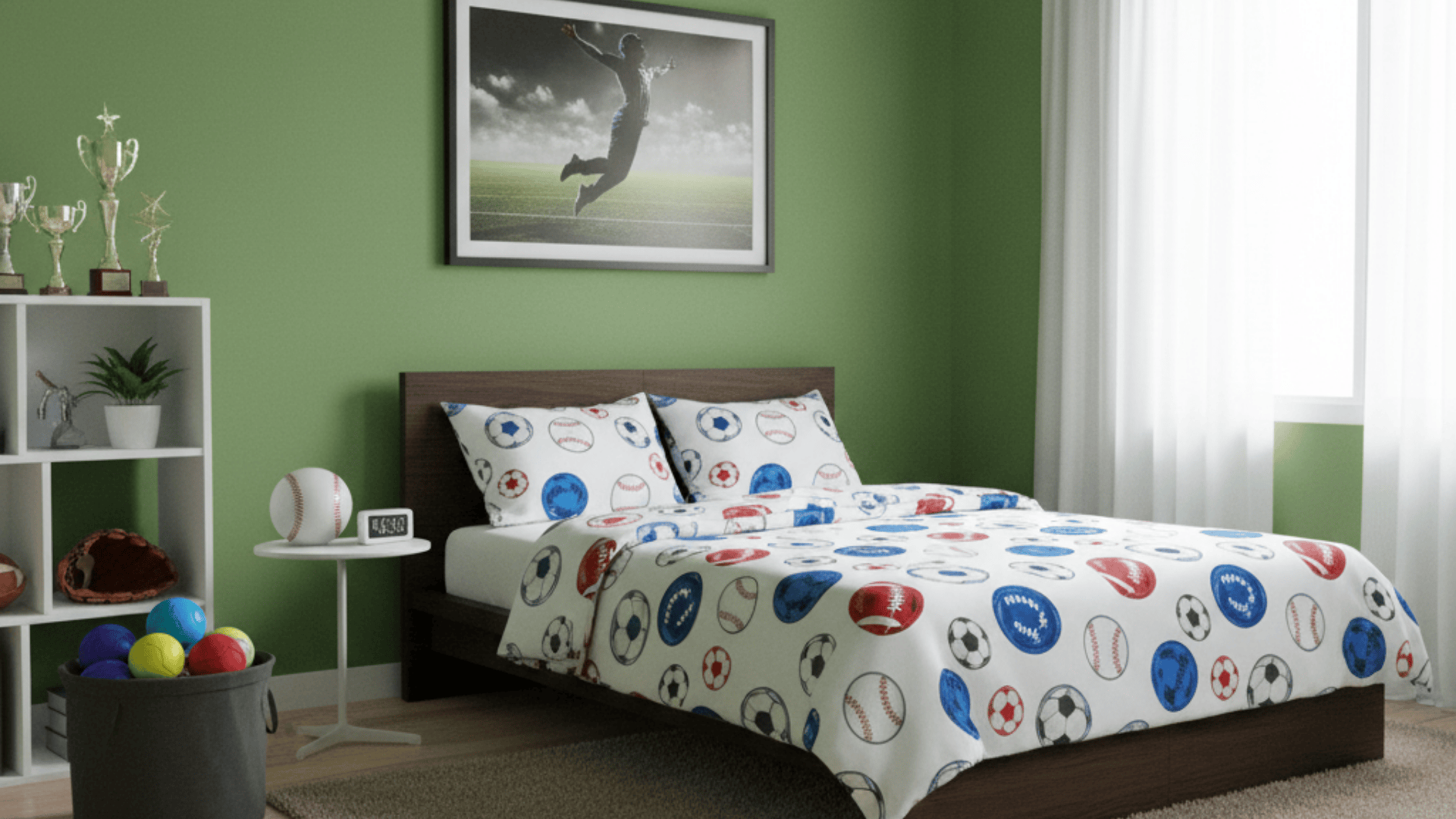
Green adds energy and freshness to kids’ rooms, making it ideal for those who love movement and play. Bright grassy tones work well with sports decals, posters, or themed bedding, creating a lively atmosphere.
Deeper shades bring coziness and focus for older kids, while all greens symbolize growth, balance, and renewal.
23. Whimsical Pinks and Purples
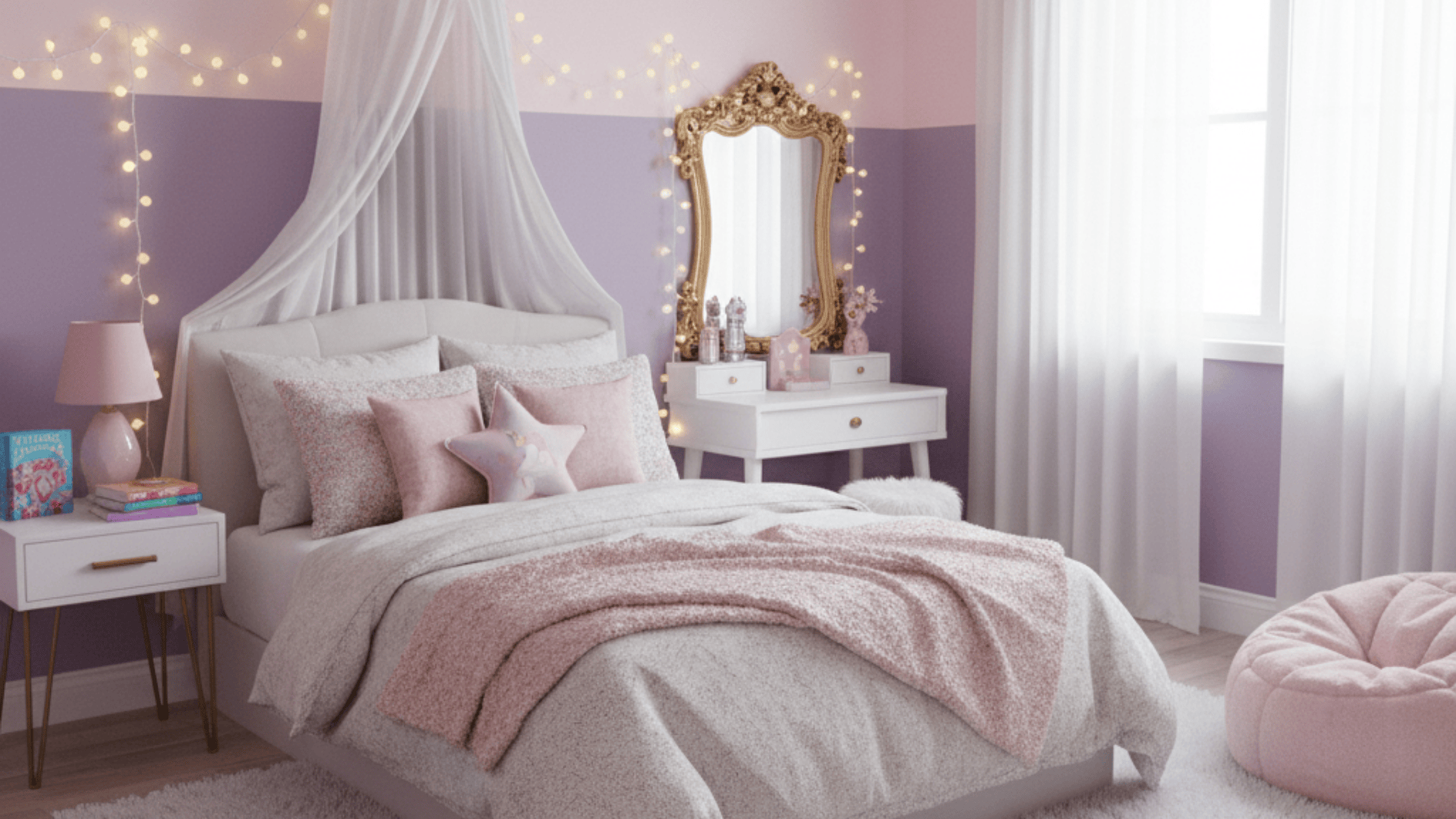
Shades of pink and purple add charm and personality to kids’ rooms. Soft tones feel gentle and playful for younger children, while deeper hues create a stylish, mature look for teens.
These colors pair beautifully with metallics, neutrals, or patterns, making the room dreamy, inviting, and full of character.
24. Gender-Neutral Earth Tones

Earthy shades like taupe, olive, and rust create a grounded, calming environment. They’re versatile and suit siblings’ shared rooms or kids who prefer a more natural, subtle style.
They pair seamlessly with wooden furniture and neutral decor, creating a warm, timeless look that grows with the child.
25. Shared Room Dual Tones
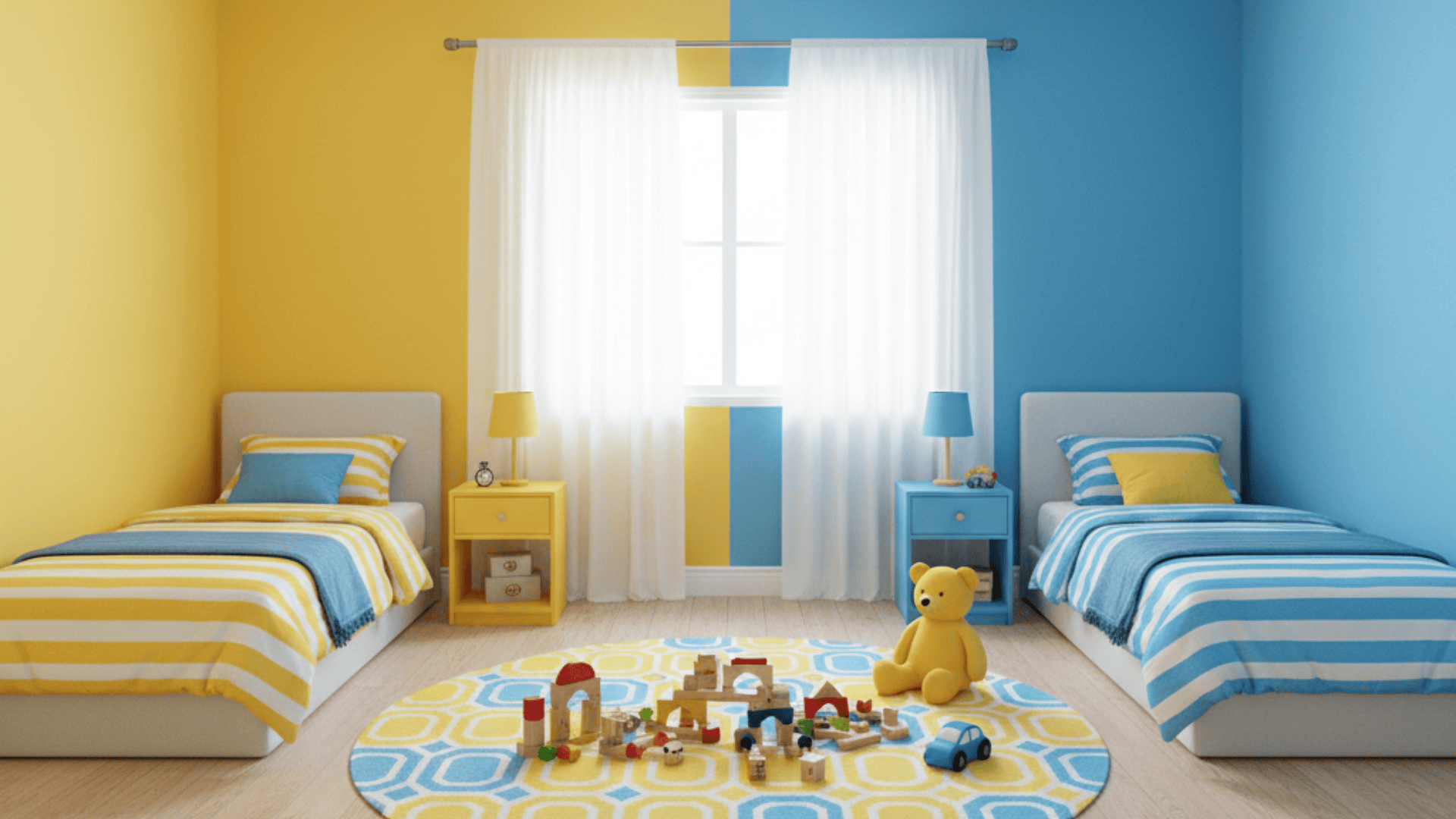
Paint one side of the room in one color and the other in a complementary shade. This gives siblings their own space while keeping harmony in the overall design.
Dual tones create visual balance and harmony, reducing conflicts over style choices. This approach also helps define study, play, or sleep zones without adding bulky physical dividers.
Choosing the Right Paint for Kids’ Rooms
When picking paint for your child’s room, you want something safe, practical, and suited to the space. The right choice will make the room look good and last longer.
- Safe paints: Go for low-VOC or zero-VOC paints. These are safer for kids, reduce strong odors, and keep the air cleaner.
- Washable finishes: Choose satin or semi-gloss finishes. They make it easy to clean marks, fingerprints, and spills.
- Durable options: Look for paints that can handle scrubbing without losing color. This is helpful in active play areas.
- Lighting matters: Soft colors work well in smaller rooms with little natural light, while bold colors shine in bright, spacious rooms.
- Room size effect: Light shades can make small spaces feel bigger, while darker tones create a cozy feel in larger rooms.
- Budget-friendly paints: Many brands offer affordable lines that still give good coverage and durability.
- Premium paints: Higher-end options often have better color depth, finish, and long-term durability.
Making smart choices with paint saves money, time, and stress in the long run. Focus on safety and practicality first, then pick colors that suit your child’s space.
Practical Tips for Parents
When painting your child’s room, planning ahead makes the project easier and keeps the space looking fresh as they grow.
- Make paint last: Use neutral base colors like beige or gray that can adapt over time. Add accents, wall decals, or themed bedding instead of repainting everything.
- Touch-up strategies: Keep leftover paint in a sealed, labeled container for quick fixes. A sponge or small brush works well to cover scratches and scuffs.
- DIY vs. professional: DIY is cost-friendly if you have the time and patience. Hiring a professional ensures smooth finishes, clean edges, and faster results.
- Washable paints: Choose satin or semi-gloss finishes that resist stains. These are easy to clean when kids draw or spill on the walls.
- Use primer first: A good primer helps the paint stick better and last longer. It also makes colors look more even and vibrant.
- Plan for furniture marks: Place bumpers behind chairs and beds. This avoids dents, scratches, and paint peeling from constant contact.
- Test before painting: Always try a sample on the wall and observe it in different lights. Colors can look very different in the morning and evening.
Taking these steps helps you save time, money, and effort while keeping your child’s room fun, practical, and easy to update.
Wrapping Up
Thoughtful paint choices can shape how kids experience their rooms. The right colors create spaces that support sleep, inspire creativity, and grow with changing needs.
From gentle pastels in nurseries to bold themes for young kids and stylish palettes for teens, every stage can be matched with a paint idea that feels right.
Safe, durable paints and simple design tricks make it easier to keep rooms fresh over time. Mixing creativity with practicality ensures the space works for play, study, and rest.
With the right approach, paint becomes more than color on the wall; it helps create a room that feels personal, comfortable, and lasting.

